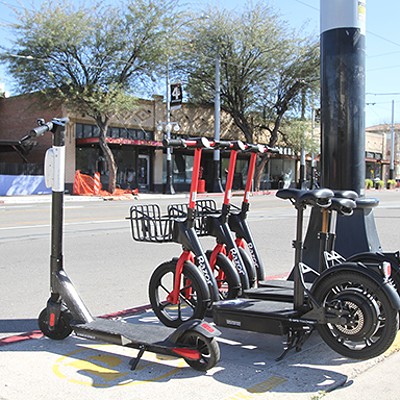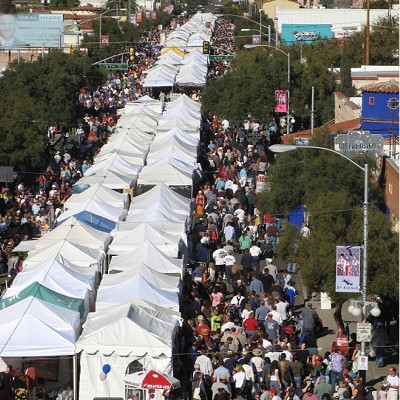Prospective central city builder Jim Campbell thinks it is time for the old structure to go. A new, wider tunnel, he says, could serve not only automobiles and pedestrians, but also bicyclists and dual trolley tracks. Besides, Campbell points out, the 70-year old Stone Avenue underpass might be preserved.
Longtime history advocate Sharon Chadwick disagrees. "I don't like (Campbell's) idea," she says, "and I don't trust (the city) to save the Stone Avenue underpass."
For the last 15 years, City Hall has planned to spend $2 million to rehabilitate the aging underpass as a pedestrian-only walkway, as part of a proposal to extend the Barraza-Aviation Parkway westward toward Interstate 10 from its present terminus at Broadway Boulevard. Next to the underpass, the city would build a new automobile and bicycle subway, which would additionally allow the historic trolley to get under the Union Pacific railroad tracks into downtown.
That same transportation plan calls for demolishing both the 75-year-old Sixth Avenue tunnel, as well as the subway on Stone Avenue, even though all three underpasses are included on the National Register of Historic Places.
But the city's two-tunnel proposal for Fourth Avenue ran into a major snag last year when the sole bidder on the construction job came in with a price 50 percent higher than the $21 million budget (See "The Price Ain't Right, Oct. 13, 2005). Transportation officials decided to regroup by adopting some cost-cutting measures while also using a "construction management at risk" process which would select a contractor based on qualifications, not price. As a result, they are now negotiating with Sundt Construction Company.
But what project, if any, Sundt will build remains undecided. Campbell, who has the right of first refusal from the city to buy the former Greyhound bus station site near Fourth Avenue, thinks the existing underpass must be replaced.
"The current plan," he says, "destroys the eastern gateway into downtown by creating pocket parks several feet above street grade which you can't do anything with." Campbell says that by revising this long-approved idea, not only would considerably more property in the area be made available for development, but also that the Greyhound site could physically be linked with the nearby Hotel Congress and Rialto Theatre.
While admitting the Greyhound property could still be developed under the current subway plan, Campbell says of the existing concept: "It doesn't make any sense at all."
Midtown City Councilmember Nina Trasoff agrees. "There's very little to recommend (saving) the Fourth Avenue underpass," she says. "Because of its narrow lanes, it's very dangerous. Plus, it's not very attractive, and the rehabilitation could be very expensive."
Campbell also labels the current Fourth Avenue subway as "a scary mugger tunnel," but those who use it disagree. A steady stream of pedestrians of all ages walked through the underpass on a recent sunny afternoon. When asked, a half dozen people all concurred with middle-aged, diminutive Anna: "It's not scary at all," she declared.
After Campbell broached the idea of replacing the two proposed tunnels with one, city Department of Transportation officials worked with him to modify the concept. They have since taken the revised plan to several city committees and received support.
When asked why this possibility wasn't considered a decade ago, Tucson's Transportation Director Jim Glock says the 2004 proposal to shift the Barraza-Aviation Parkway exclusively to the north side of the railroad tracks, which could preserve the Stone Avenue underpass, didn't exist then. Plus, he adds: "The need for developable land downtown was different 10 years ago."
Glock believes Campbell's proposal, with its land advantages, will also save a significant amount on construction costs. But he acknowledges the city has already spent $2 million on preparing plans for the two tunnels, and would have to spend as much as $2 million to design a different structure.
Glock also indicates revising the plan could delay completion of the project by as long as 12 months. "In about three years from now," he says hopefully, "it would be done."
But for up to 18 months during that time, there would be no direct access from downtown to the Fourth Avenue business district. Because the two-tunnel concept permitted one underpass to always remain open during construction, this change concerns John Sedwick, the Fourth Avenue Merchants Association's executive director.
"Cars can detour," Sedwick says, "but for bicyclists and pedestrians, it's a different story." To address this problem, solutions such as a shuttle bus are being considered, including a shuttle to transport Tucson High students going to and from the downtown Ronstadt Transit Center.
Sedwick adds that some merchants along Fourth Avenue fear the financial fallout of an extended street closure. He indicates the association is still evaluating the idea.
"We'll see what it finally ends up with," Sedwick says. "(The plans have) been bouncing all over the place."
The constantly changing concepts also concern Chadwick. "This has been back and forth so many times," she says. "I think the city keeps coming up with new proposals because they don't know how to get the parkway through downtown."
Next week, Campbell's proposal will be presented to the Tucson-Pima County Historical Commission. After that, Glock hopes to take it to the City Council in June.
While Glock and Trasoff emphasize that even if the Fourth Avenue underpass is demolished, the Stone Avenue subway "may" be saved, Chadwick, a member of the Historical Commission, isn't buying that argument.
"I just don't trust them," she says of City Hall.












